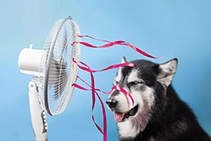
Summer and fall can be fun for pets, but excessive heat can result in severe consequences such as heat stroke. Before embarking on your outdoor adventures, ensure that you take proper measures to keep your pet cool. You and your pet can enjoy being outdoors in the warm weather while remaining safe. Here are some tips to help you understand heat stroke warning signs and prevention.
Understanding Heat Stroke
Heat stroke, also known as heat exhaustion, occurs when a pet loses the ability to maintain a cool body temperature and thus starts overheating. It usually happens due to factors such as humidity and high temperatures.
Pets cannot cool off by sweating and only do so by panting, so they have a risk of overheating. A high risk for heat stroke occurs when pets are left outdoors on hot days or are exercising too hard.
Warning Signs of Heat Stroke
Some signs can indicate that your pet is suffering from heatstroke. They include:
Rapid breathing
Excessive drooling
Diarrhea
Heavy panting
Bright red gums
Vomiting
Hot skin
Imbalance
Lethargy
Dry mucous membranes
Muscle tremors
Pupil dilation
Dealing With Overheating in Pets
Heat stroke can be treated effectively and has good chances of full recovery. However, early intervention is vital to ensure no lasting health issues. If you notice signs of heat stroke, you must take immediate steps to cool down the pet.
Remove the animal from the situation by bringing them indoors where it is cool. Splash or spritz some cool water and use a fan to blow a gentle breeze towards the pet. Avoid using ice-cold water as it can make the situation worse.
You can place the pet on a cooling mat to get rid of extra heat. Take your pet to the vet immediately.
Treating Heat Stroke
It is crucial to realize that heatstroke can lead to severe health complications if left unaddressed. The condition can require emergency care. The vet will check the pet’s vital signs at the clinic and take the rectal temperature.
Treatment will depend on the pet’s condition and the severity of the heatstroke and include cooling treatments, intravenous fluids, and medications. The vet will test and monitor organ function and recommend ongoing treatment to ensure optimal recovery.
Preventing Heat Stroke
Following the proper prevention steps can help keep your pet safe during hot days. It is essential to understand your dog breeds susceptibility to heat stroke. Brachycephalic breeds have a higher risk of suffering from heat stroke. These are breeds that have flat faces and short noses.
Keep your pet cool by avoiding walks or outdoor activities during the hottest hours
Always ensure proper hydration for your pet, including during your walks
Plan your walks in areas where you can find shade, and take frequent breaks
You must never leave your pet alone in a hot car, even for a few minutes
Ensure that your pet takes cool-off breaks from playing on hot days
Heatstroke can be very dangerous and lead to death if warning signs go unnoticed. You should act immediately if you notice any signs of overheating. Elderly, overweight, and pets with underlying health complications have an increased risk of heat stroke.
True Animal Vet is a general and urgent care veterinary practice that is opening soon! We are well equipped to advise you on more information regarding heat stroke in pets and look forward to seeing you in office soon. Stay up-to-date with our opening information by following along at trueanimalvet.com!
Dr. Kathryn Salcetti
Director of Urgent Care
True Animal Vet










